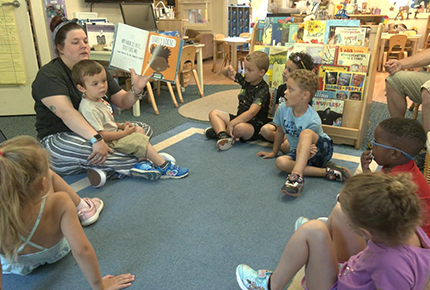Discussing Differences with Young Children
Dr. Theresa Bouley, Professor of Early Childhood Education, Eastern Connecticut State University: Early childhood educators are in the ideal position to support and develop children’s understanding about equity and diversity. Young children are aware of equity; they know when something is fair, something is not fair.
Child 2: Here. You can have some of mine.
Dr. Bouley: They have that sense of empathy and compassion. So it’s really important to expose young children to diversity as much as possible, because the more experiences children have with difference, the more comfortable they are with difference. And they develop a vocabulary that’s needed to talk about difference, and they don’t feel that sense of nervousness that sometimes adults feel in talking about differences.
Child: Yours has brown skin, Lily.
Dr. Bouley: So it’s important to allow children to recognize, to be able to talk about some of the differences that they see, to be able to label, to be able to talk about their experiences.
Teacher: They do.
Dr. Bouley: There are a lot of studies that show that even at the age of six months, children are already starting to recognize differences between gender and race. By the time children go through preschool and head to Kindergarten, they’re showing play preferences for their own race. So because young children are recognizing these differences, we can’t not talk about them. If we don’t want to talk about it, or if we feel uncomfortable talking about it, it’s just going to transmit to the children as well.
Teacher: (reading) “My hair is free, just like me. I am born to be awesome. Lively locks.” Look at those beautiful lively locks.
Dr. Bouley: For children to be comfortable around differences, they need to be comfortable with themselves.
Teacher: Muggaga, what do you like about your hair?
Dr. Bouley: For instance, there’s a term called colorism where students, children at a very young age show preference for lighter skin tone, regardless of their own skin tone. It’s really important for those children’s identity, their self-worth, their social emotional development, that we have conversations about race and ethnicity, so that we can sort of combat some of those notions of colorism or the way in which the media and other aspects of our culture portray lightness as more favorable than dark.
Teacher: I notice that your hair is smooth on the sides. It’s shaved on the sides; it’s nice and smooth. And then it’s a little taller on the top. You have a little bit more hair on the top.
Child 1: My daddy has that.
Teacher: Your dad has hair like that? Wow.
Child 2: And my hair is black.
Teacher: And your hair is black. You’re right.
Dr. Bouley: It’s especially important, I think, to have these discussions about race and ethnicity in classrooms that are homogeneous to make sure that we are giving children experiences with that diversity. So they also can feel comfortable talking about race and can develop the vocabulary and the confidence in having these conversations.
Child: Yes, some people do, but some don’t.
Teacher: Does each family look exactly the same?
Dr. Bouley: I think a lot of white teachers, white early childhood educators, are uncomfortable or afraid to talk about race or ethnicity, because they’re afraid to say something wrong. Maybe they’re afraid to use the wrong term, or say something that could be interpreted as racist. We all shy away from things that we don’t feel comfortable doing. But I think that’s the whole point here, is that we have to move ourselves into those uncomfortable zones and have these conversations.
Teacher: Remember yesterday we started to talk a little bit about friends being the same and different than you?
Dr. Bouley: I also think it’s really important to think about why teachers of color might feel uncomfortable having these conversations. And I think sometimes teachers of color might feel that it’s not a safe space for them to have these conversations in their schools. They might feel like they’re not the ones who should be responsible for always bringing up these issues. White teachers need to take that responsibility, and not wait for teachers of color to bring these things to our attention. And I think that that can happen through discussions and creating safe spaces where we can have those discussions.
© 2023 Center for Early Childhood Education at Eastern Connecticut State University
May be reprinted for educational purposes.



